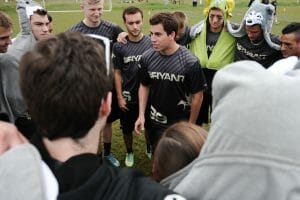|
|
DAVIDE’S DOCTRINES: VERTICAL STACK |
|
|---|
FEATURED ATHLETES: CUSB Shout & CUSB La Fotta
Hi! My name is Davide Morri. After 23 years in the ultimate world, I’ve realized how difficult it is to find articles and books that connect high-level technical and tactical issues to their implementation on the field. In this column, I will try to provide some concepts, coaching techniques, and drills to improve your routine practice. I hope this work will be useful to your training and a good read for all!
THE VERTICAL STACK CAN BE USED as a set play to initiate disc flow. Its vertical (end zone to end zone) structure has the significant advantage of creating large areas of open space on the field that favor horizontal (sideline to sideline) disc movement, especially in the under space and the deep space, while keeping the dump space clear for resets.
While there are many variations of vertical stack, this article will analyze some versions that begin with six vertically stacked cutters and one handler outside the cutter stack. We will also discuss the side stack “storm system,” an offensive play system that can be cycled through indefinitely during a point and allows more flexibility in player positions, creating dynamic and effective disc flow. Finally, we will provide drills and methods to practice using this structure with your team.
|
|
BASICS: STRUCTURE & SPACING |
|
|---|
When learning any version of vertical stack, it’s challenging but important to train for good spacing, which requires well-coordinated movement, placement, and timing from all players on the field. Furthermore, ideal spacing changes continually depending on the position of the disc and the defense, so it’s crucial to focus on this element of vertical stack during your practice.
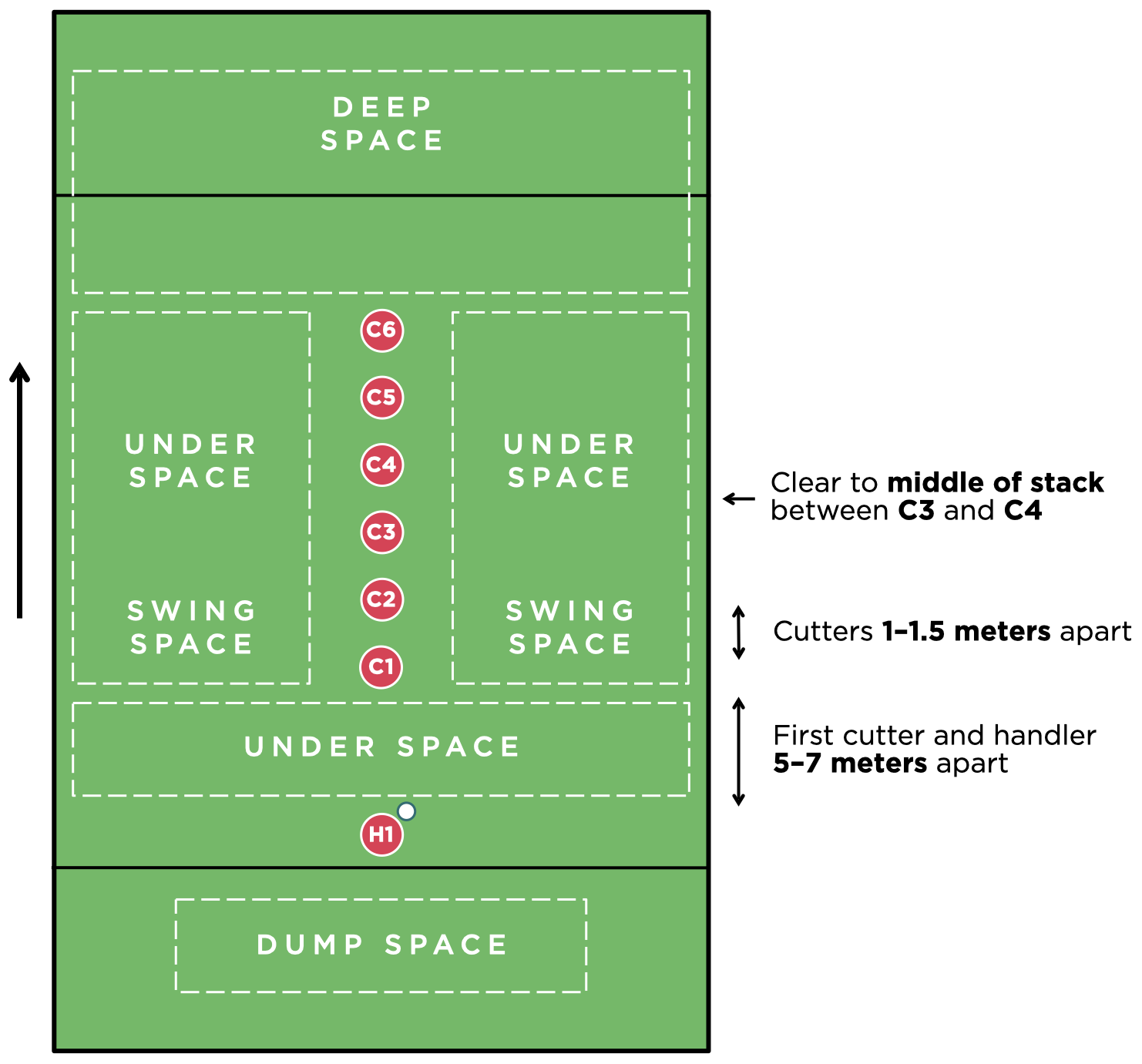
In the diagram above, you can see the basic structure of a central stack with one handler and six cutters. Despite their position in the cutter stack, players in positions C1 and C2 will usually function in a handler role, cutting to swing the disc in horizontal space or reset the stall count; the rest of the stack will function primarily as cutters, cutting to receive the disc further downfield.
Cuts typically come from positions C6 and C1, while cutters clear to the center of the stack between positions C3 and C4. This way, as cutters cut from the ends of the stack and clear to the center, you can create repeatable cut sequences that continually supply the handler with vertical passage lines. If no throw is made downfield, a reset in the dump space remains an option.
- Many teams prefer playing with two handlers and five cutters, but in my opinion, a 1-6 central stack structure allows more versatility. Because the 1-6 stack system allows players to enter the disc flow from different positions, the defense has to adjust how they mark their player. Having players who can exchange positions within a system means the team can be a greater threat, and they can leverage disc flow and make it more effective.
- As in all offensive movement, the secret to coordinating this kind of play is for each player to anticipate the movements of their teammates, particularly in positions C6 and C5 and in positions C1 and C2.
- It should be noted that if the stack is further from the attacking end zone, the first priority will be a cut from C6 because there is more space downfield; as the stack advances down the field, the priority will be a cut from C1 in order to use available space more effectively.

The side stack has some similarities to the central stack. The first cut is typically initiated by C6 or C1, while cutters clear to a position between C3 and C4. Likewise, players can also exchange positions in this play, passing from handler to cutter or vice versa. An advantage of the side stack is that if the horizontal position of the disc changes, players can clear the vertical space in front of the disc and re-establish the cutting line elsewhere on the field, quickly establishing the biggest possible under space for disc movement.
- It will be the job of players in positions C1 and C2 to communicate the new position of the side stack to their teammates. They also have to keep an eye on the positioning of the stack at all times, ensuring that it isn’t too far from the disc.
- At midfield, this formation should shift to a central stack, concluding the point with an end zone play.
|
|
APPLICATIONS: PLAYS & SYSTEMS |
|
|---|
As you can see in the videos below, there are various ways to train the side stack “storm” system. (The name “storm” was chosen because players’ movements are reminiscent of things flying away in a storm.)
- The first sequence shows a side stack advancing a disc using cutter-style under cuts from the back of the stack (position C6), with players clearing to the front of the stack.
- The second sequence shows the stack advancing the disc using handler-style upline cuts from the front of the stack (position C1), with players clearing to the back of the stack.
- The last sequence shows a team using the full flexibility of the vertical stack, with first cuts coming from the back of the stack, but swings or resets to the front of the stack remaining an option, with players clearing to the middle of the stack (between positions C3 and C4) after throwing or not getting open.
The video above shows a 5-on-5 game of mini using the principles of a 1-6 side stack to move the disc in a smaller space. The point begins with an under cut from the back of the stack, but the handler chooses instead to throw to the front of the stack, moving the disc from the center of the field to the left sideline. As the disc’s horizontal position changes, the stack is re-established on the other sideline, creating as much open space as possible in front of the disc.
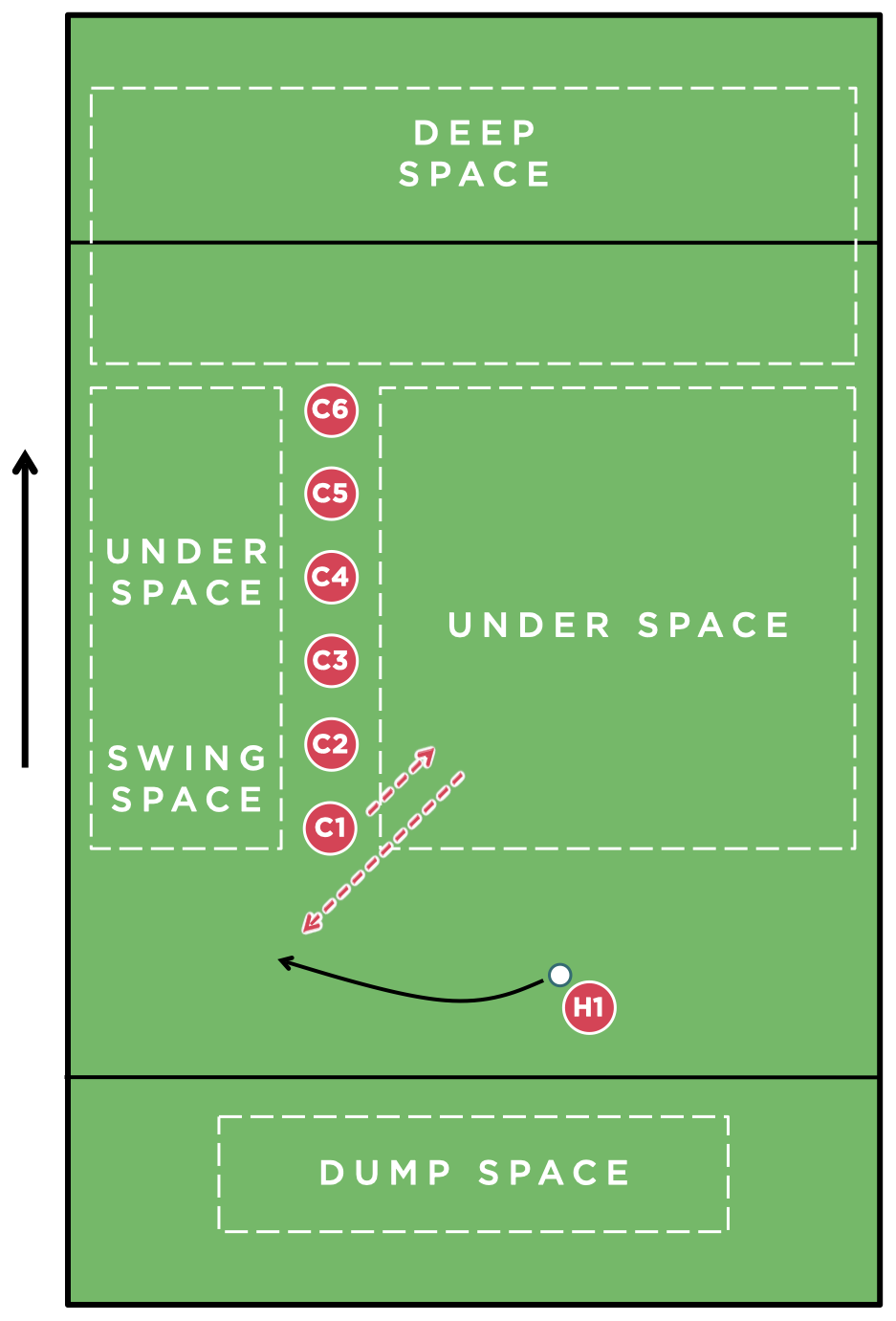 |
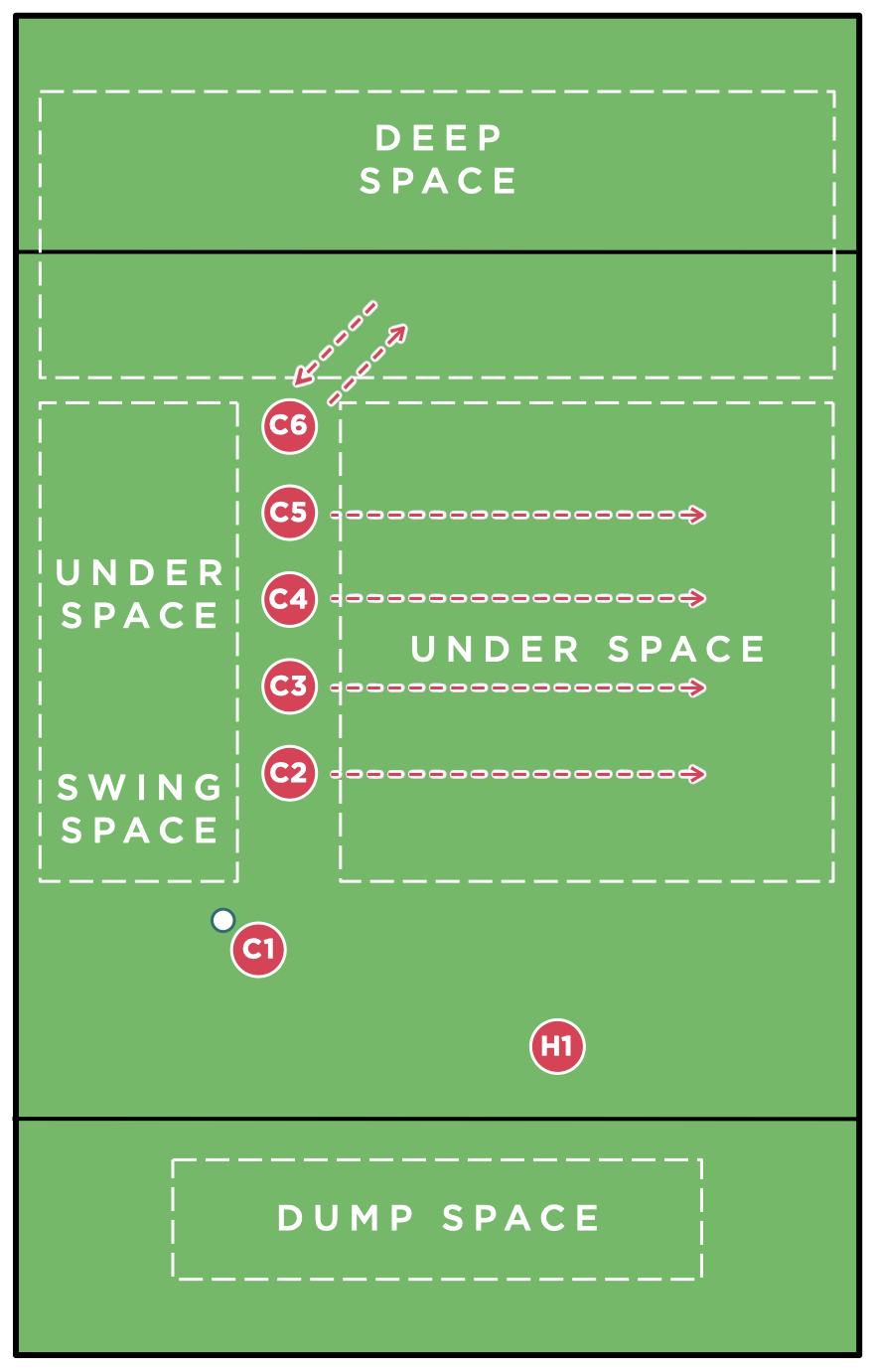 |
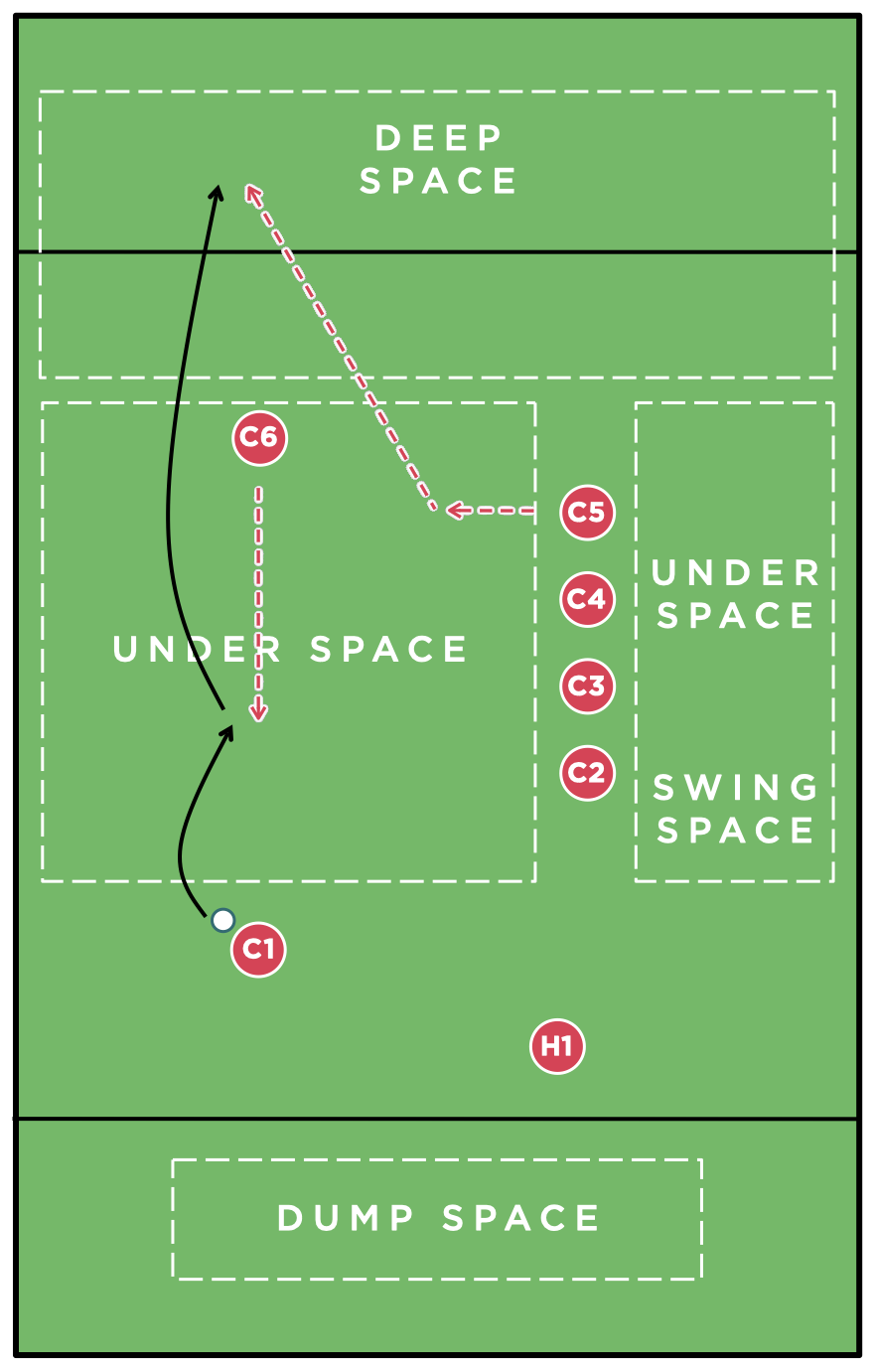 |
|---|---|---|
STEP 1 1. Closest cutter in the stack — really functioning in a secondary handler position — cuts for a swing from primary handler. |
STEP 2 2. Middle four cutters clear to the under space, opening space midfield, while furthest cutter fakes into the deep space. |
STEP 3 6. Furthest cutter cuts toward the disc for a pass while the last back in the stack cuts deep, and the play is completed in the end zone. |
|
|
TEACHING: DRILLS |
|
|---|
In the following diagrams, you will find three preparatory exercises for the vertical stack to use in your team practice.
The exercises described below are designed to be indefinitely repeatable, with all the players on the field involved. We suggest you set a time limit or a maximum number of passes.
- Players set up in three lines as shown, with players in Line A to one side and players in Line B and Line C aligned vertically in the center of the field.
- Player in Line A holds the disc, waiting for a player from Line Bto cut into the dump space for a reset pass. Player from Line B cuts out, then toward the dump space.
- Player from Line A resets the disc to the player from Line B, then cuts horizontally to receive a pass on the other side of the field in a give-and-go motion.
- As the disc is moved in the backfield, a player from Line C cuts from the back of the stack, juking in before cutting out diagonally to receive a deep throw.
- Play is completed in the end zone.
Rotation of the drill is Line A to Line B to Line C.
Notes:
- While cutting, always look at the disc.
- Focus on changing direction safely and efficiently with both footwork and body control, using one or two feet as well as engaging larger muscle groups.
- As a variation, the player from Line C can receive the disc in the under space while another player cuts from Line C to the deep space for a continuation in the end zone. In this setup, players should pass through Line C twice.

- Players set up in four central lines as shown, with players in Line A and Line B acting as throwers and players in Line C and Line D acting as cutters.
- Players in the cutter line cut vertically toward the facing throwing line, then diagonally toward midfield to receive a pass from the opposite throwing line. (Cutters from Line C will receive a pass from Line A, while cutters from Line D will receive a pass from Line B.)
- After completing their throws, players from the throwing line must sprint and clear to the end of the opposite cutting line, passing the three cones in the middle of the drill, similar to clearing to the middle of a stack in a game setting. (Throwers from Line A will clear to Line C, while throwers from Line B will clear to Line D, preparing to receive a disc from the line they just left.)
Rotation of the drill is Line A to Line C and Line B to Line D and vice versa. Keep the exercise running at a good pace with multiple groups of players in motion.
Notes:
- While cutting, always look at the disc.
- Focus on changing direction safely and efficiently with both footwork and body control, using one or two feet as well as engaging larger muscle groups.
- As a variation, this drill can also be performed with defense on the thrower only and a “buddy” standing nearby and giving verbal feedback on their mark.
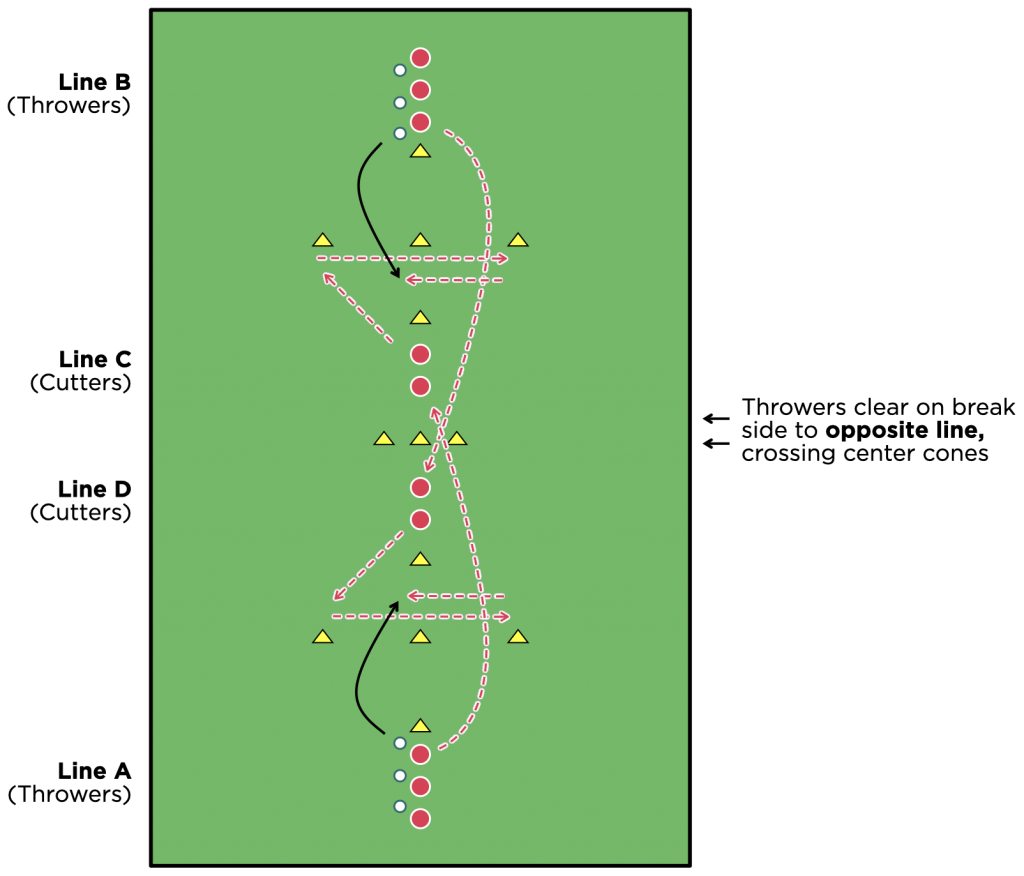
- Players set up in four central lines as shown, with players in Line A and Line B acting as throwers and players in Line C and Line D acting as cutters.
- Players from the cutter line cut diagonally toward the facing throwing line on the thrower’s open side, then horizontally to the opposite cone on the thrower’s break side, finally cutting to the middle cone to receive a pass. (Cutters from Line C will receive a pass from Line B, while cutters from Line D will receive a pass from Line A.)
- After completing their throws, players from the throwing line must sprint and clear to the end of the opposite cutting line, passing the three cones in the middle of the drill, similar to clearing to the middle of a stack in a game setting. (Throwers from Line A will clear to Line C, while throwers from Line B will clear to Line D, preparing to receive a disc from the other throwing line.)
Rotation of the drill is from Line A to Line C and from Line B to Line D and vice versa. Keep the exercise running at a good pace with multiple groups of players in motion.
Here is the basic movement of this drill:
Here is the drill with defense on throwers and cutters:
Notes:
- While cutting, always look at the disc.
- Focus on changing direction safely and efficiently with both footwork and body control, using one or two feet as well as engaging larger muscle groups.
- As a variation, this drill can also be performed with defense on the thrower only and a “buddy” standing nearby and giving verbal feedback on their mark.
Davide Morri
More Features
Project-Manage Your Tournament To Success
With this adaptable planning spreadsheet and phase-by-phase guide, you too can manage a small- to medium-sized weekend event with flair!
Resources for College Ultimate Frisbee Captains
Resources for College Ultimate Frisbee Captains
Ultimate Revolution: Mike Payne’s Journey From Collegiate Bridesmaid To The Pinnacle Of The Sport
It’s possible that nowhere in ultimate has a record of failure led to so much success as in the case of Mike Payne.
We Are Not Twins
Australia's Phillips sisters are two of the most important factors in the Firetails' success at WUGC 2016, but they are contributing in different ways. As usual.

